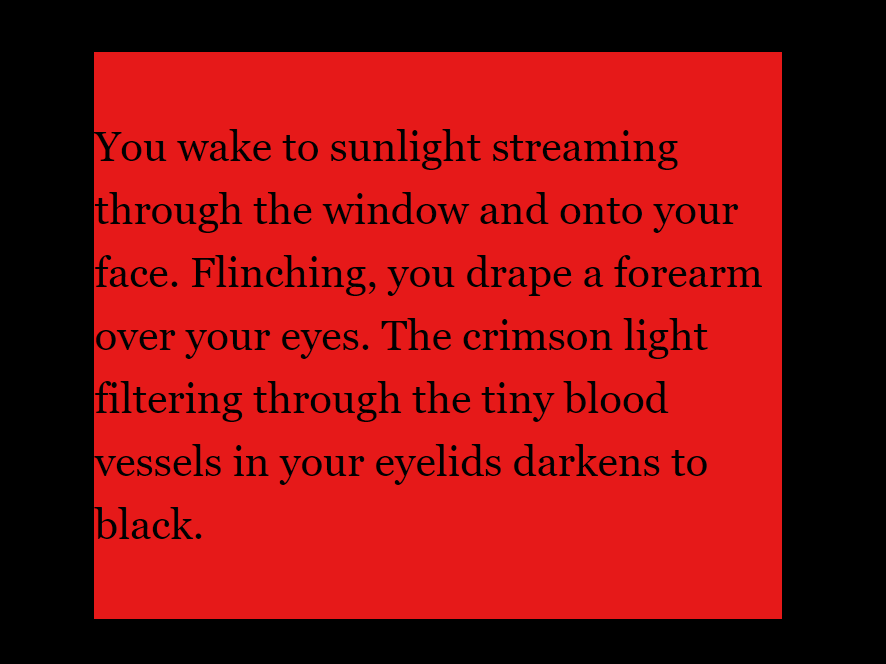Rosamede's Coming Out: A Nonbinary Self-Love Story
Sara Raffel
This narrative piece titled Rosamede’s Coming Out: A Nonbinary Self-Love Story explores the intersection of electronic literature and physical performance while also challenging the tension between perceived binaries, including the physical/digital, masculine/feminine, and designer/interactor. As originally imagined, Rosamede’s Coming Out consists of two parts: a branching narrative game with several potential endings and an aerial hammock performance piece that changes based on the ending the audience chooses. Ahead of the performance, the audience can play the branching narrative in the form of a Twine game. However, given the current public health situation limiting performances, only the Twine portion is available at this time.
The story itself is an updated version of Shakespeare’s As You Like It from the perspective of Rosalind, a character who is banished from court and ventures into the woods with her best friend, Celia. To avoid the dangerous circumstances of being two young women traveling alone, Rosalind cross-dresses for their journey, and her masculine persona, Ganymede, immediately attracts the attention and affection of another woman, Phoebe. In the traditional play, Rosalind must carefully balance these identities that lead to the conclusion in which she reasserts her feminine persona and marries her male lover, Orlando. In the process, Rosalind conspires and succeeds in untangling the confusion of identities and has several other young couples married in heteronormative relationships. Rosamede’s Coming Out, rather than relying on the tidy denouement of Shakespeare’s comedic standards, retells the story in modern times based on what might have happened if Rosalind had not shed, but rather embraced, their nonbinary identity, and the Twine game offers three potential endings to this effect. Each ending corresponds to a different 5-minute aerial dance piece intended to encapsulate the moment in which Rosalind comes to this personal realization, and one piece will be performed based on the conference audience’s choices while playing the digital narrative.
In Electronic Literature (2018), Scott Rettberg writes, “Electronic literature can be thought of as situated somewhere between a number of related practices and cultures, including print literary culture, arts practice, computer science, and performance,” and Rosamede’s Coming Out: A Nonbinary Self-Love Story explores this space “between” practices and cultures by transforming a traditional theatrical piece into a branching interactive narrative, affording the opportunity of a multiplicity of endings. The aerial performance aspect then refigures the traditional story for a different but still performative medium, inspecting the interior feelings of a single character at a pivotal moment in their story. In this respect, the piece follows Brenda Laurel’s model of mediated collaboration between designers and interactors, allowing for a co-creation of the final performance according to the interactor’s vision of the story’s ending (Computers as Theatre 2014). However, the performative medium allows for a further co-presence of designer and interactor, bringing the mediated aspect of the piece to the forefront, rather than allowing it to surface as a side-effect of interactivity.
About the Artist
Sara Raffel’s primary research examines how cognitive psychology—particularly narrative transportation theory—can contribute to understanding virtual reality stories and their impact on players’ feelings toward social issues. She has a particular interest in how interactive narrative can effectively communicate scientific and technological topics, such as climate change and risk. As part of her dedication to the study of social justice, technology, and community stories, she also serves as director of oral histories on the LGBTQ History Museum of Central Florida’s board of directors, where she conducts and archives interviews with members of Orlando's LGBTQ+ community.
Sara has recently published in journals such as Visual Ethnography and Meaningful Play, and has presented her work at a wide array of national and international conferences, including Foundations of Digital Games, IEEE ProComm, and the Popular/American Culture Association.
